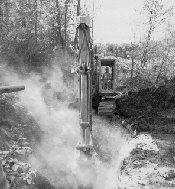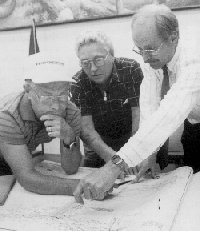By the mid-1980s, there had been a broad community consensus that a countywide sanitary sewer system would be best for the environment, for economic development, and for quality of life. The challenge was to correct the mistakes of the past by eliminating existing small treatment plants and septic tank systems, and by providing sewers for new development. Construction proceeded rapidly.
In the North County area, MSD had completed more than $26 million in construction and had eliminated 29 small treatment plants by the end of 1996. In addition, more than 3,000 property owners in neighborhoods formerly served by septic tanks had been able to get MSD sewer service, at a total cost of about $18 million.
In the Pond Creek area, more than $16 million in projects had been completed, eliminating 12 small treatment plants, by the end of 1996. As part of the action plan, MSD absorbed the old Poplar Level Road Sewer Construction District — the last of the special districts formed in the 1960s to provide sewers for the suburbs. Future work was planned to eliminate more than a dozen more small plants, and to provide sewers to more than 1,800 homes on septic tanks.
In southwestern Jefferson County, where challenges to the old West County plan had delayed sewer expansion for nearly two decades, there was a change of heart as the 1990s began. Business owners began urging residents to support a campaign for sewers — and residents, tired of coping with the problems of aging septic tanks and seepage pits, began to respond. MSD divided the expansion plans into neighborhood projects, issued guaranteed maximum assessments, and gave property owners the opportunity to vote. By the end of 1996, more than two dozen major sewer projects were being planned and constructed along both sides of Dixie Highway. Eventually, the projects will serve more than 8,000 customers.
In the Floyds Fork area, where new development had been blossoming since the 1980s, plans were under way to build smaller "subregional" plants to serve the new residential and commercial areas.


MSD Photos by Martin E. Biemer
As part of the action plan, MSD took over the Jeffersontown plant and sewer system in 1990, then began upgrading the plant to meet new environmental standards. The system would prove very problematic for MSD; during wet weather, stormwater entering the sanitary sewer lines would increase the flow by more than five times. Extensive work would be scheduled to seal the leaky old pipes — and to eliminate improper storm water connections to the sanitary sewers.
The next major expansion was the construction of the Cedar Creek plant south of the Fern Creek neighborhood. The plant was completed in the summer of 1995, and work was well under way on its network of major sewer lines. Eventually the plant will eliminate nine small treatment plants, eliminate many septic tank systems, and provide sewer service for one of the fastest-growing areas of the county.
Another major expansion was almost ready for construction at the end of 1996 — the Floyds Fork plant and its network of major lines in eastern Jefferson County. The plant site, on the east side of Floyds Fork north of Interstate 64, included a large natural park area to be managed by Jefferson County. The plant would eliminate several small treatment plants, while providing service for another of the fastest-growing areas of the county.
The Middle Fork of Beargrass Creek, which extends through Cherokee Park and eastward to Anchorage, reached a major milestone in 1994: its last small treatment plant, at Foxboro Manor, was closed. Small plants had proliferated in the Middle Fork basin after the health department banned septic tanks there beginning in 1959; the plants were considered temporary measures to allow development to continue until MSD lines could be extended to serve the area.


MSD Photos by Martin E. Biemer
Across County Lines
The early 1990s brought MSD’s first concrete moves to provide service in adjacent counties. The first to be served were relatively small areas just across the county line, where septic tanks and poorly functioning sewers would affect streams that flowed into Jefferson County.
Soon, an interlocal agreement was negotiated with government in Oldham County to provide more extensive service. In mid-1996, an agreement was reached for MSD to provide service to the city of Crestwood in Oldham County. Crestwood was to build a sewer system, then turn it over to MSD for operation and maintenance. The wastewater was to be treated at MSD’s Hite Creek plant.
Also in mid-1996, MSD approved an amendment to the Pond Creek action plan to include areas served by 12 small treatment plants in Bullitt County. A study aimed at eliminating these plants through MSD’s expansion program was to be completed in 1998, and MSD was talking with Bullitt County officials about resolving the issues involved.
MSD History continued - Treatment Plants Closed Through MSD's Expansion Program


